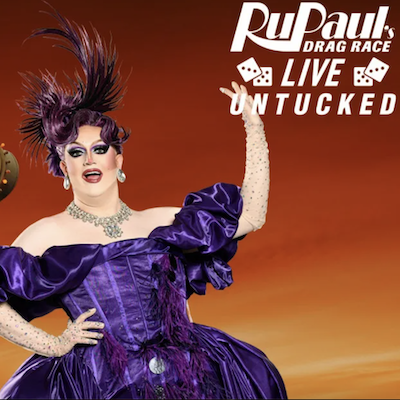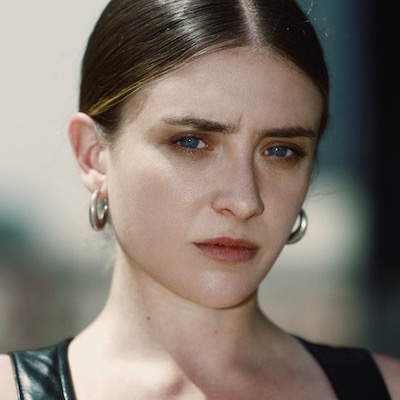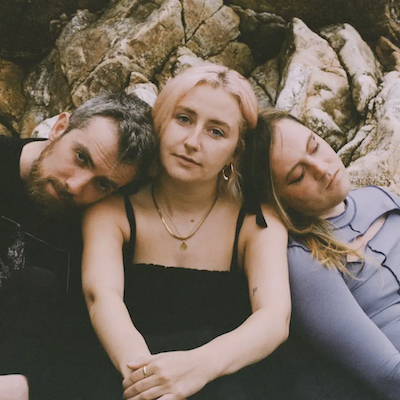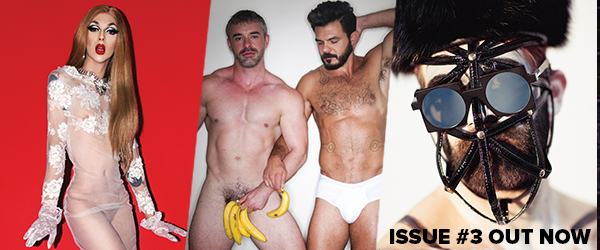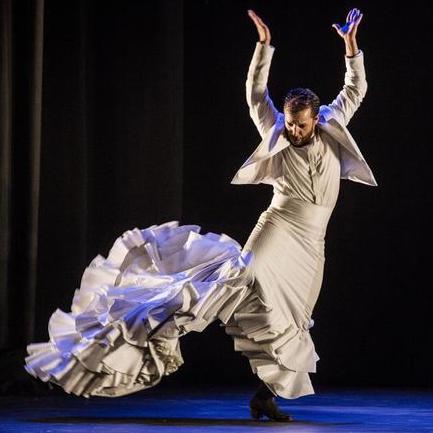
Pre-Quarantine, Loverboy was excited at the prospect of witnessing Manuel Liñán take to the stage for his show, Baile De Autor, as part of Barcelona’s Dansa Festival 2020. Alas those dreams have been put on hold but they have given us one more thing to look forward to once Miss Rona has exited stage left….
Manuel began to dance Flamenco at a young age but was immediately frustrated with the dance’s specific gender roles. Originally laughed at by his teachers for not dancing ‘like a man’, he learned to follow their rules before ripping up the very rulebook. Consistently challenging the idea of what is and what is not Flamenco, Manuel now performs in costumes associated with both genders and sometimes even both at the same time.
Manuel tells Loverboy about how he has come from being a bullfighter’s son who danced too effeminately to staging his own shows across Spain as well as in London, New York and Sydney’s Opera House and winning numerous awards for his dancing and choreography.
For our readers outside of Spain, can you explain a little about the origins of Flamenco?
Flamenco’s origins are difficult to explain. You can generalize by saying it is how a community began demonstrating its way of loving, of weeping, of trying to survive, of celebrating! This then manifested itself through its art. Flamenco had many influences before it became professionalised.
And your personal journey with Flamenco started when you were young, right?
Yes, Flamenco has always been present in Granada, my hometown. My father was a bullfighter, which is connected with Flamenco. We learned Flamenco in class at school. There was something in its musicality and movement that appealed to me.
Like a lot of dance, Flamenco has always had very rigid roles for each gender. How did you find that?
When I started to dance, the differences between how men and women should dance were very defined. I always heard the phrase, ‘You have to dance macho, like a guy!’ I was also curious about moving like the women, but my teachers never gave me that option. This was when they began to ridicule me for dancing effeminately. ‘Men should not move their hands, they should always be upright.’
Plus the men’s clothes were boring, always the same – high trousers, shirt, waistcoat and a jacket. There were certain accessories for each gender to wear. Although sometimes the women got to dress like the men, to make up numbers. But never the other way round.
You’ve become known as someone who challenges the rules of flamenco. When did you begin to shake things up?
At first Flamenco was only a vague attraction, then I realized that it had become a tool that helped me express myself clearly, not through words, but through music, movement and history. That seemed fantastic to me.
Challenging Flamenco really began when I was around eleven and people were saying I danced ‘effeminately’. I wanted to dress differently too, not just in ‘male’ clothes. But I felt humiliated, so I avoided these attacks and fell in line with their rules.
Much later, when I was twenty and living in Madrid, I was less afraid of modifying my dancing. I began to move my hands in the way I‘d always wanted, then my hips, etc…
And now you dance wearing a ‘bata de cola’ – the dramatic tail of a dress usually worn by women in flamenco. When did this begin?
In 2005, I was part of Rafaela Carrasco’s dance company and she choreographed a piece for us where the men wore ‘batas.’ But it was a very sombre piece and although the men were wearing ‘batas’, they still used their bodies and arms in a very masculine way.
After that Belen Maya invited me to collaborate with her, wearing both a ‘bata’ and a shawl. It was at this point that I began to feel nervous. I told her I would think about it, but two seconds later I had already said, ‘Yes.’ She knew I was anxious, but I had already created choreography for dancers wearing a ‘bata’ and a shawl, even dancers in my own company!
From this point on, I started to let go of the fear of representing myself naturally, showing how I felt inside – all thanks to Belen’s invitation in 2014. The piece was very well received by both the critics and the public. It also received many insults, but I think because of my age it did not affect me so much. Although I was hurt by such disrespect from some, I was equally comforted by so many others.
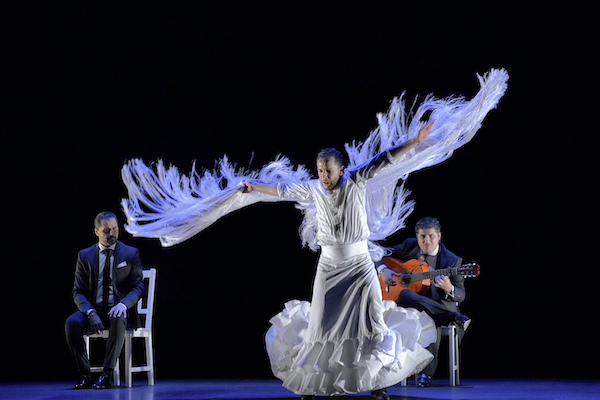
How did you challenging these rules of gender within Flamenco coincide with your own ‘coming out’?
I came out when I was 20 and living between Madrid and Granada. The people around me had already guessed my sexual orientation. My family too, but it was a very taboo subject. I never discussed it, unless they asked me. I avoided the subject, even though my bullfighter father’s brother, my uncle, was trans.
It was my mother who eventually asked me. We were both scared my father would find out, although I think really he already knew. I have still never spoken with my father about my sexual orientation because by now it is obvious. He saw on television that his son was dancing onstage with a ‘bata’ and shawl! Haha…His reaction was not as bad as I had expected but I still believe that even now, it’s tough for him that I continue dancing like this. He respects me, but I think he’s having a hard time adjusting.
Let’s go back to the first time you danced properly with a ‘bata.’
This has really been a long transformation for me, not just one moment. As I said earlier, the first time I danced with a ‘bata’ was officially in the dance troupe of Rafaela Carrasco. I was nervous but I had my colleagues Marco Flores & Daniel Dona dancing alongside me. I remember how scared we all were of the Maestras (female Dance officials) that had defended us, but we were also nervous because it was a new addition for us. Although that particular dance was more virile, or at least more associated with the male way of dancing. The movements were straight, we had to keep our wrists still. Even though we danced with ‘batas’ there was no liberation in our interpretation.
And the next step?
From there I incorporated the ‘bata’ into two of my shows, 1980 and Mundo y Aparte, neither of which received much publicity. But when I danced in Los Invitados with Belen Maya, to whom I will always be grateful, I really took the biggest step – wearing both the ‘bata’ and the shawl. Here I was free to dance as I had always wanted. I was afraid, expecting to be insulted or booed, but my body was telling me, ‘This is you. Show your real self.’ And so I did.
I will always hold the public’s reaction dear to my heart. I felt accepted, respected and very emotional. The insults came later via social media and some colleagues too but I got over them.
I performed again with the ‘bata’ and shawl in both Reversible and Baile de Autor. I didn’t want people to think I wore them as a one-off, purely for a role. I can use them when and wherever I want. Why shouldn’t this accessory be appropriated?
I concur! Where did it take you next?
Then along came VIVA!, it really was the show of my dreams and one that totally transformed me. I not only wore a ‘bata’ but also makeup, a wig, flowers and more. I had only ever danced like that as a child, in my room, where no one could see and those were sad memories.
When I performed VIVA!, I was conflicted emotionally. I wanted to show the real me, but at the same time I felt like I was showing a very intimate part of my life. But it was marvellous then, and still is now, to dress in womens clothes, a wig, makeup, etc.
What was Spain’s initial reaction to what you were doing?
There were divided opinions. The public’s reaction on the night was beautiful. I will always keep their applause in my heart. Then insults came later on social media, colleagues looked at me differently, respected industry people could not understand how a man could dance like this.
But from this show, I became the face of the Festival de Jerez and won the Critic’s Choice. The press have treated me very well – the public too, although I have seen some people walk out. Ha!
I also remember one colleague telling me, ‘I wish we could have seen this when we were young.’ And before, some men were not even allowed to study it in some schools, now there are schools where it is not only permitted but treated naturally. This fills me with satisfaction.
I also have kids that send me videos of them dancing in a ‘bata’ and shawl as if it were second nature – although they too continue to be disrespected in some colleges.
Since you first began challenging Flamenco’s gender norms, how has Flamenco changed?
Now there are some of us that are not afraid to be judged for experimenting – even if we continue to be insulted online. This negativity has always existed. Now is the time for this style to be accepted.
You have said before that there is a Spanish woman that lives inside of you! Does she have a name?
I don’t consider myself like a woman. I think that what lives inside me is the impulse to fight for the right to appear how I want, in dress and in movement. Now that woman does not live inside me, she lives outside of me. She has long hair, a lot of makeup, a beard, painted lips, flowers, a uniform, polka dots, moderation. She’s seductive. She’s provocative. She comes to the surface when I want.
But my aim is not to become a woman. We keep separating genders. I recently saw an ad promoting makeup for men. Makeup exists with the same result for any individual. Why separate them by gender? I don’t understand it.
Will you continue to play with roles of gender within your performances?
Above all, I want to keep experimenting with it and to continue normalising it. In my current show, Baile de Autor, I dance with a ‘bata’ just because I fancy it, nothing more. In VIVA! It was the same, but with the added drama that dressing with a woman brings.
I was looking forward to seeing Baile de Autor but obviously during quarantine it has been postponed.
Baile de Autor will definitely be staged in Barcelona in the future and that fills me with great joy.
For audiences outside of Spain, Rosalia has been really in the spotlight for updating Flamenco. What do you make of what she is doing?
I think it’s great. Every artist should do what they want, then it’s up to the public to decide whether to consume it or not. Who am I to judge someone? I like Rosalia. Artists have always played with Flamenco. There has always been this constant battle between, “What is and what is not flamenco?” Always between the conservatives and the progressives. But everything should be respected.
Lastly we are named after the iconic song, ‘Loverboy’ by Mariah Carey, so we always ask, ‘What is your favourite Mariah Carey song?’
‘I Want To Know What Love Is’ because I think now would be a good time to find love and for all of us to be able to show this love in public!



